Most LinkedIn posts never see the light of day, with 49.31% getting under 10 likes.
You spend time writing, hit publish, and the result? A handful of likes, maybe a stray comment.
You’re not alone.
The average engagement rate on text-based LinkedIn posts is roughly 4%, which means most posts aren’t even seen. For better reach, you need structure and clarity. Also, a strong hook to draw readers in the first three seconds.
Regardless of your role, you want to drive conversations, build authority, and attract opportunities.
This guide shows you exactly how to write a LinkedIn post that actually gets engagement with examples and tools.
Why Most LinkedIn Posts Fail to Engage
The hard truth is that countless LinkedIn posts never break past a few likes or comments. The problem isn’t effort. It’s posts that often disappear in feeds with weak hooks, drab takes, and no clear value for the reader.
The average engagement rate (by impressions) on LinkedIn is around 5.2% in 2025, up from 4.56% in 2024. For brands, the average engagement per follower is about 0.41% in 2024, meaning even if you post well, many posts get minimal interaction.
It could be because of
Generic takes: Surface-level opinions without new insights don’t stand out.
Weak hooks: If the first sentence doesn’t make someone stop scrolling in 2–3 seconds, the algorithm ignores the rest.
Walls of text: Long paragraphs with no breaks, no bullets, or spacing are hard to scan in the feed.
Lack of proof: Claims without numbers, examples, or case studies feel empty and are less shareable.
Self-centered content: Posts that promote without giving value, or that appear sporadically, don’t build momentum or algorithmic trust.
Proven Types of LinkedIn Posts That Drive Engagement
One of the best practices for LinkedIn posts is using formats that consistently outperform others. These styles capture audience attention but also encourage meaningful interactions that increase visibility.
Educational: Step-by-step advice that solves a clear pain point and gets shared widely
Story-driven: Relatable wins, failures, or lessons that spark genuine conversations
Data-backed insights: Posts with numbers, benchmarks, or metrics that build trust
Contrarian: Content that challenges assumptions and invites debate
Conversation starters: Blunt questions or polls that draw quick engagement
Customer and team spotlights: Human stories that create authenticity and stronger reach
How to Write Engaging LinkedIn Post: A Step-by-Step Process
Step 1 – Define the Job Your Post Needs to Do
Every LinkedIn post has a job. It could inspire, educate, spark conversation, or build authority. Without that clarity, even a well-written post risks being ignored.
When the job isn’t defined, posts become vague. They become rambling thoughts, have an inconsistent tone, or a mix of ideas that leave readers unsure of the point. The result is low engagement, because people scroll away when they don’t immediately see why the post matters to them.
So before drafting, ask yourself, “After reading this post, what should my audience think, feel, or do?”
For example, comedy writer Helena Langdon recently shared a witty post about how AI interprets human writing.
The job of her post wasn’t to teach or promote; it was to entertain. That clarity made the writing sharper, the humor more intentional, and the comments section more alive.

Step 2 – Mine Real Insights, Not Just Opinions
Surface-level content gets ignored fast. Anyone can post the typical “work hard” or “stay consistent” content.
They’re not novel. They’re not helpful.
To stand out, add data, case studies, or lived experiences in your posts.
For example, did you increase your SaaS sales? Add screenshots of your growth graph. Explain what you did that brought on the change.
Got organic views on socials? Show what you did differently.
Use tools like Google Trends, feedback from customers, or LinkedIn’s own analytics to see what your audience really responds to and tweak your content strategy accordingly.
For example, Justin Welsh posted about how he crossed 250M impressions on LinkedIn (with visual evidence), where he shared specific, actionable takeaways rather than vague advice.
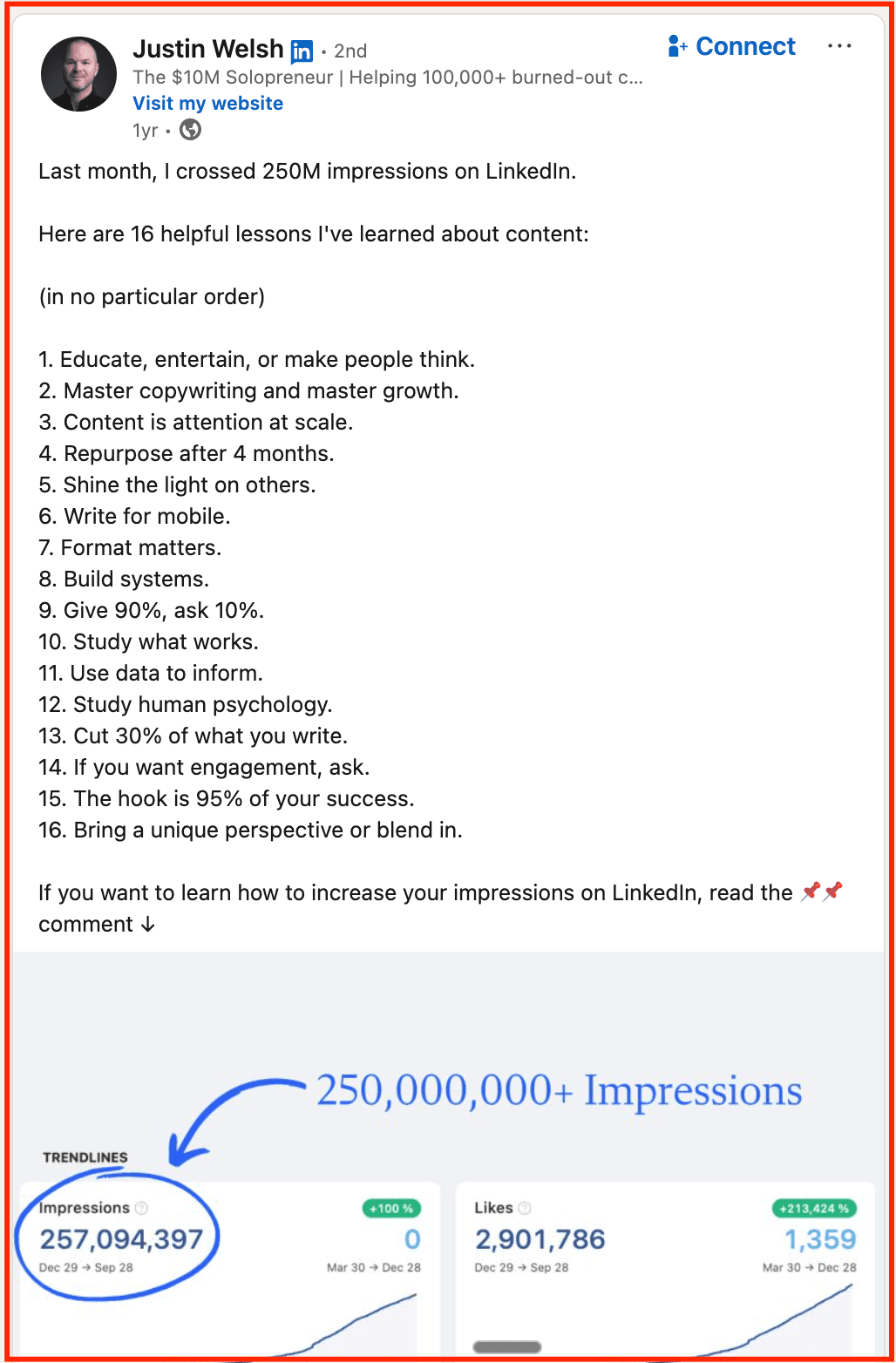
The clarity in what worked and what didn’t with his content, how he writes, and more, pulled in strong engagement.
He even shared bonus tips in the comments. That kind of anchored, insight-driven writing builds trust and encourages interaction far more than mere opinions.
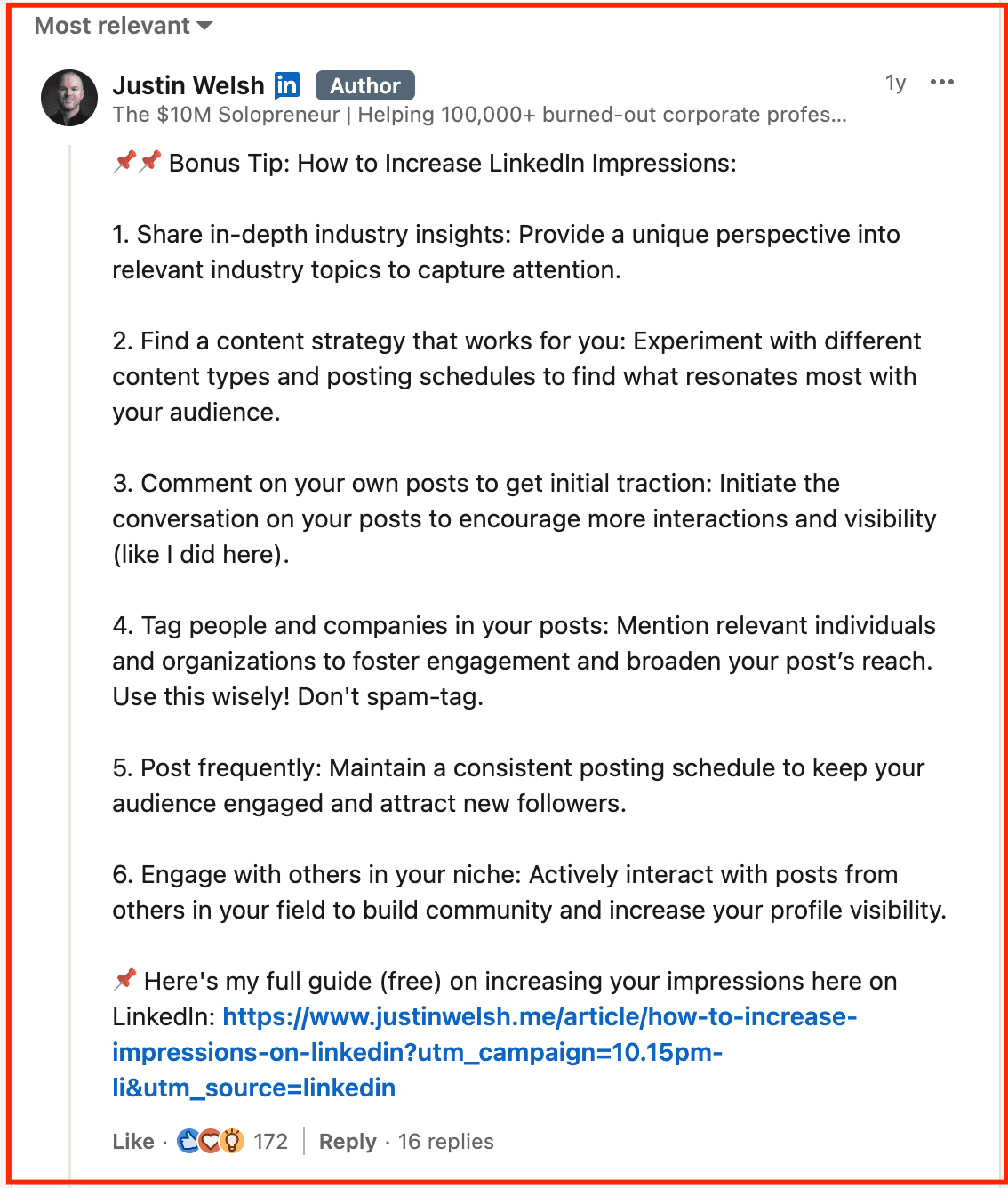
Step 3 – Craft a Hook That Earns the First 3 Seconds
LinkedIn’s algorithm rewards dwell time. If people don’t stop to read the beginning, your post won’t get seen. That means the first sentence must do heavy lifting.
But a strong hook isn’t just about pleasing the algorithm. Earning your reader’s attention is key.
The hook sets the tone, frames the value, and convinces people your post is worth their time. A simple way to test it is to ask — if my audience only read the first line, would they feel curious enough to keep going?
If the answer is no, rewrite it until the opening creates either tension, surprise, or clear value.
Some hook styles are proven to work well in 2025:
Contrarian truth — “Most employee advocacy programs fail. Here’s why.”
Micro-story start — “Three years ago, I nearly shut down my startup…”
Data-based — “85% of posts get less than 10 likes. Here’s how to be in the 15%.”
LinkedIn creator Chris Donnelly begins his post with a sharp hook.
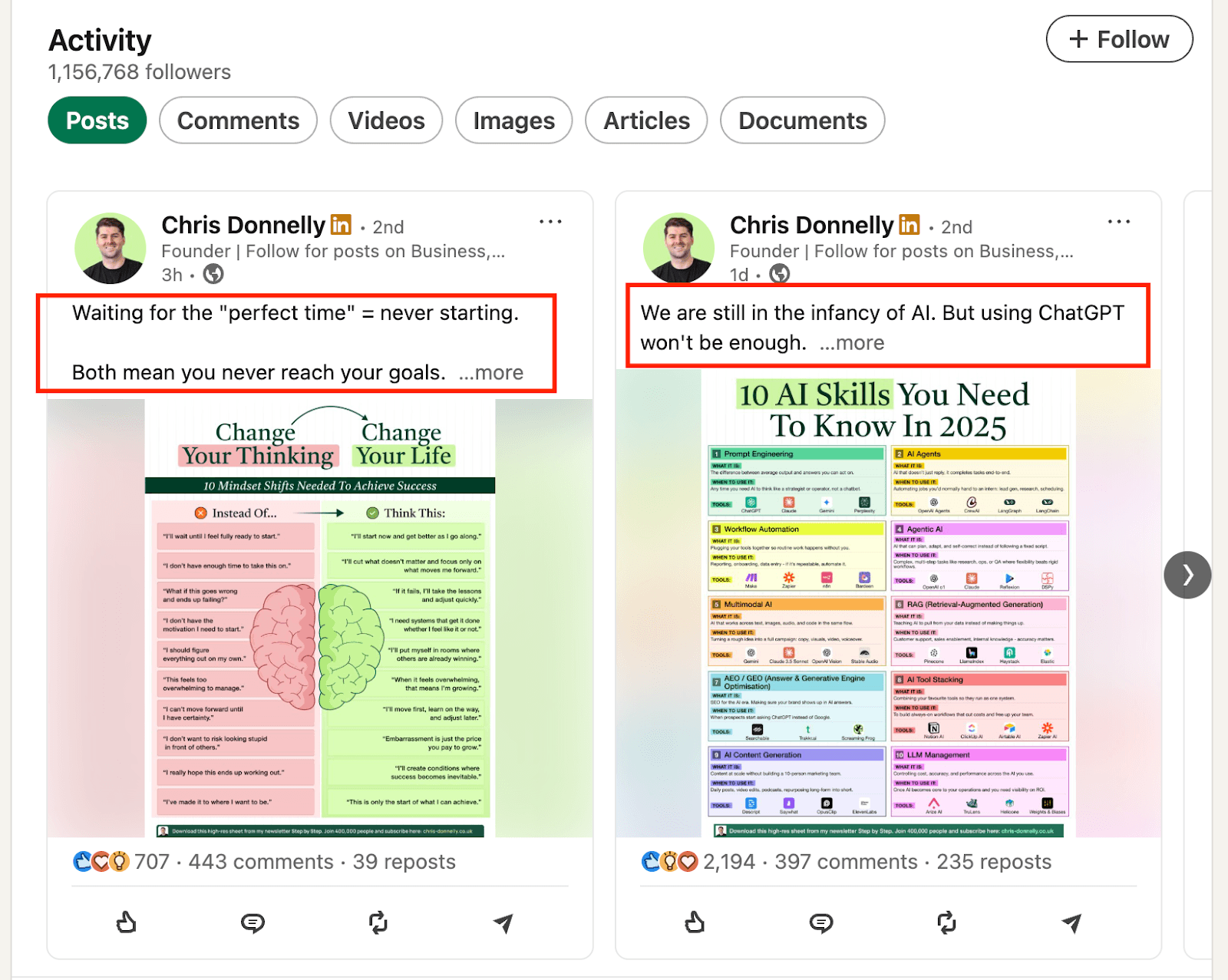
For instance, this post opens with “90% of a high-performing post: The hook.”
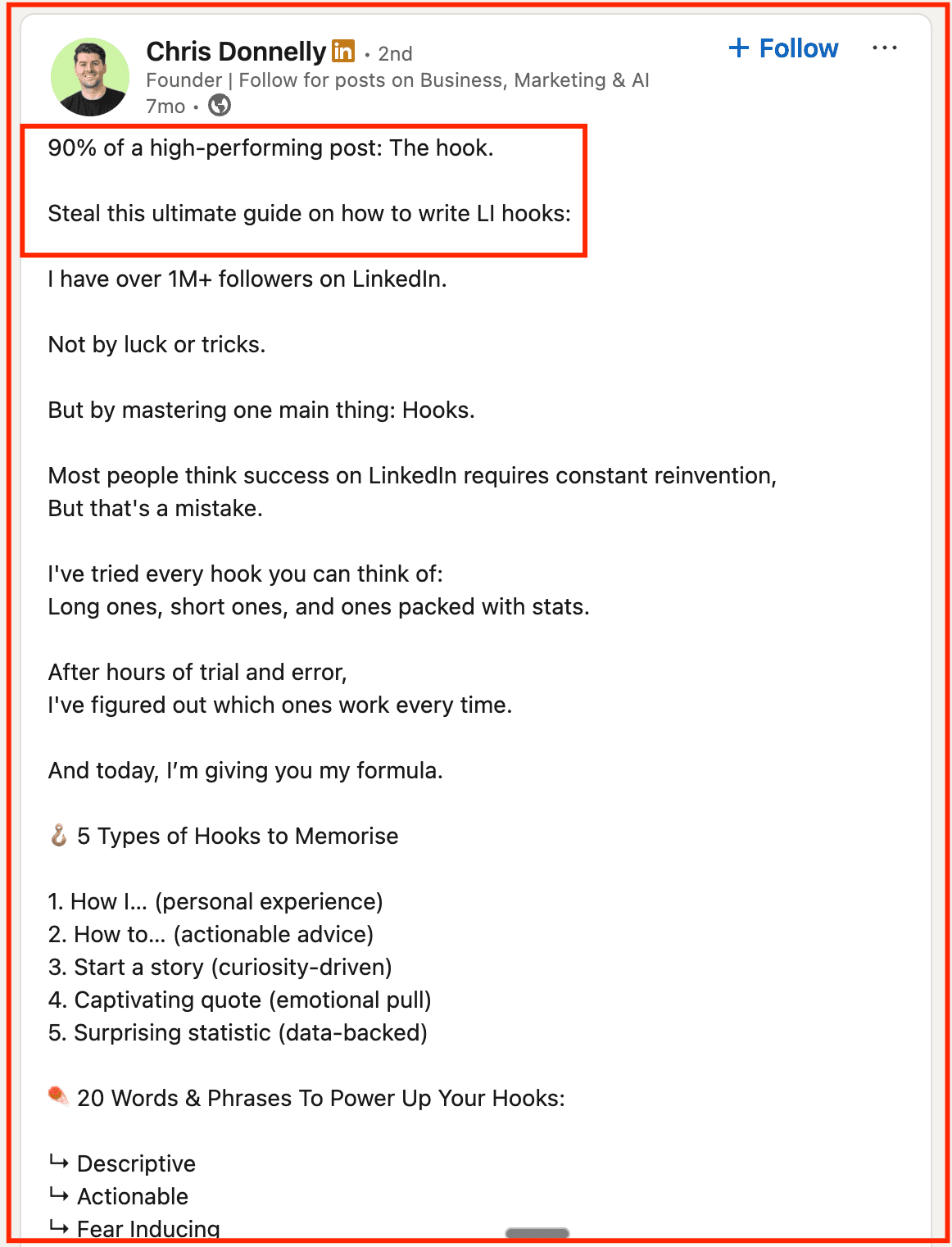
That opening line framed the entire discussion and invited people to stay and learn, resulting in significant engagement.
When you write your hook, lean into the job you defined.
If your post’s job is to persuade, lead with a bold claim.
If it’s to open dialogue, ask a provocative question.
When drafting, experiment with 3-5 variations before deciding. It can be tedious, though.
Tools like Supergrow’s hook generator make this process faster, so you have multiple scroll-stopping options tied to the problem-solution you want to highlight.
Step 4 – Use Data, Numbers & Proof Points
Specificity builds trust. Saying “we increased leads” is forgettable, but saying “we increased leads by 47% in 3 weeks” makes people stop and pay attention.
Some examples include revenue milestones, percentage growth, customer acquisition statistics, or even the time saved from implementing a new process. These figures reduce vagueness, signal credibility, and make your claims harder to dismiss.
Numbers act as proof that your ideas work in practice. This doesn’t always mean massive case studies. Small but clear metrics can anchor your post.
Get these from tools you already use, like engagement rates inside LinkedIn or Instagram analytics, CTR or conversion data from your campaign dashboard, or follower growth trends over a set period.
You could open with "our CTR doubled after rewriting the headline” or “we cut meeting prep time by 30 minutes using this system.”
These micro-metrics feel concrete without oversharing sensitive data. You can also reference external benchmarks or industry reports when personal data isn’t available, so that your post has authority and context.
For instance, marketer Katelyn Bourgoin wrote about how her small business generated over $425,000 in 90 days.
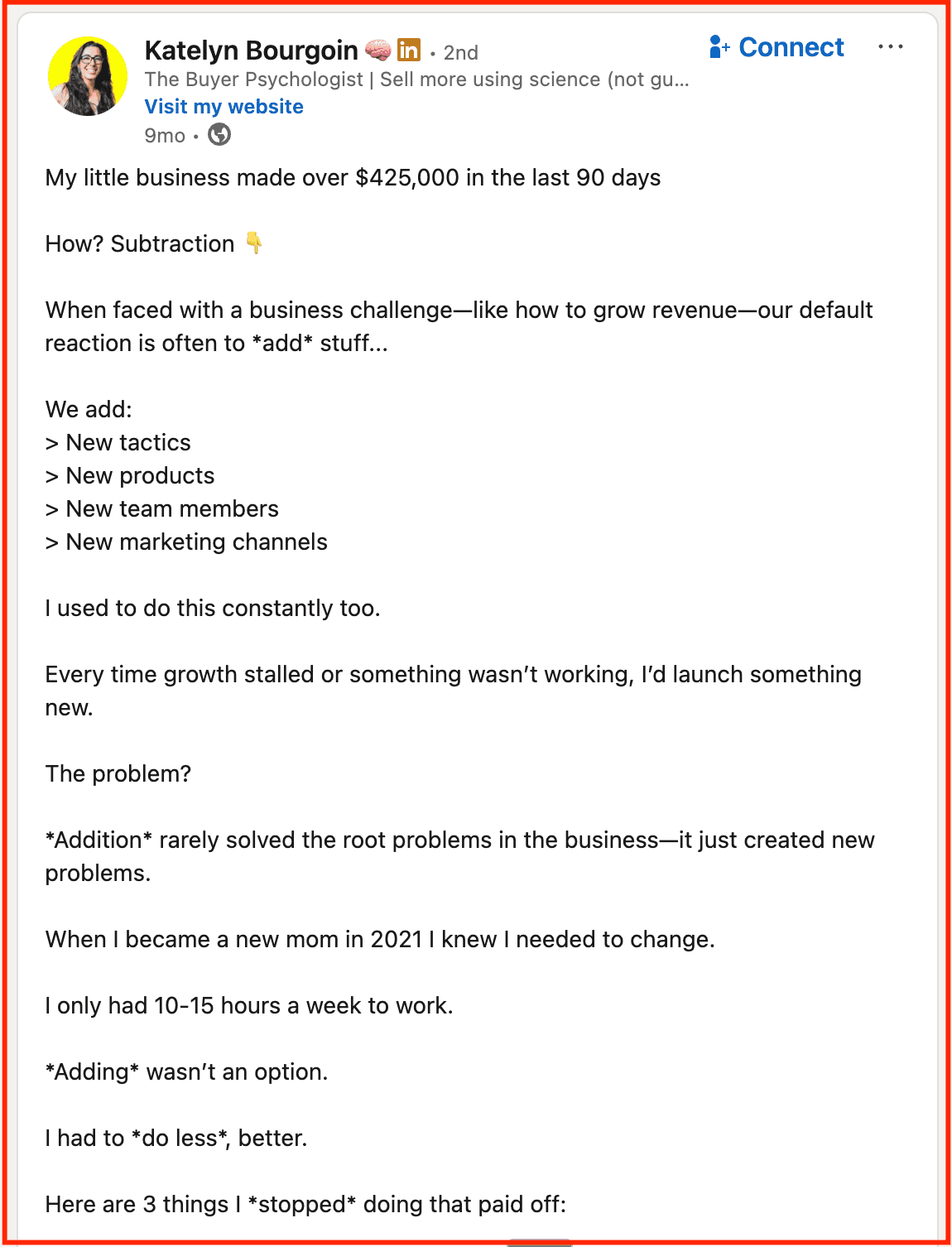
Instead of speaking vaguely about “growth,” she put a clear number upfront and then explained the steps behind it. That specificity made the post far more compelling. It showed proof, offered lessons others could apply, and got solid engagement.
Step 5 – Structure the Middle for Skimmability & Value
LinkedIn posts work in an “F-shaped” pattern. People skim the opening lines and scan for bullets or bold statements before deciding whether to stay. That’s why long walls of text often underperform. And since LinkedIn is built for scannable posts, the hook and the middle section matter. Make the crux of your post skimmable so your audience doesn’t disengage.
A simple framework helps:
Hook → Context → Value → CTA |
Where,
Hook — First line that grabs attention
Context— Set the scene with background
Value — Share the key insight or takeaway
CTA — Invite engagement or next steps
Let’s compare 2 posts-
Post A crams a whole story into a block of text. Readers have to struggle to find the point. Most may skim past without finishing. As a result, the post sees fewer comments and minimal dwell time, which signals to LinkedIn that it’s not worth amplifying.
Post B breaks the same idea into 2-3 short, scannable points. Each has a takeaway for readers in seconds. This makes people pause longer, react to the part that resonates, and even comment with their own examples. More dwell time and interaction extend the post's reach.
Olga Andrienko, the former VP of Brands at Semrush, often uses the latter style in her posts, whether educational or engagement-based. This clear structure makes posts easier to read, remember, and interact with.
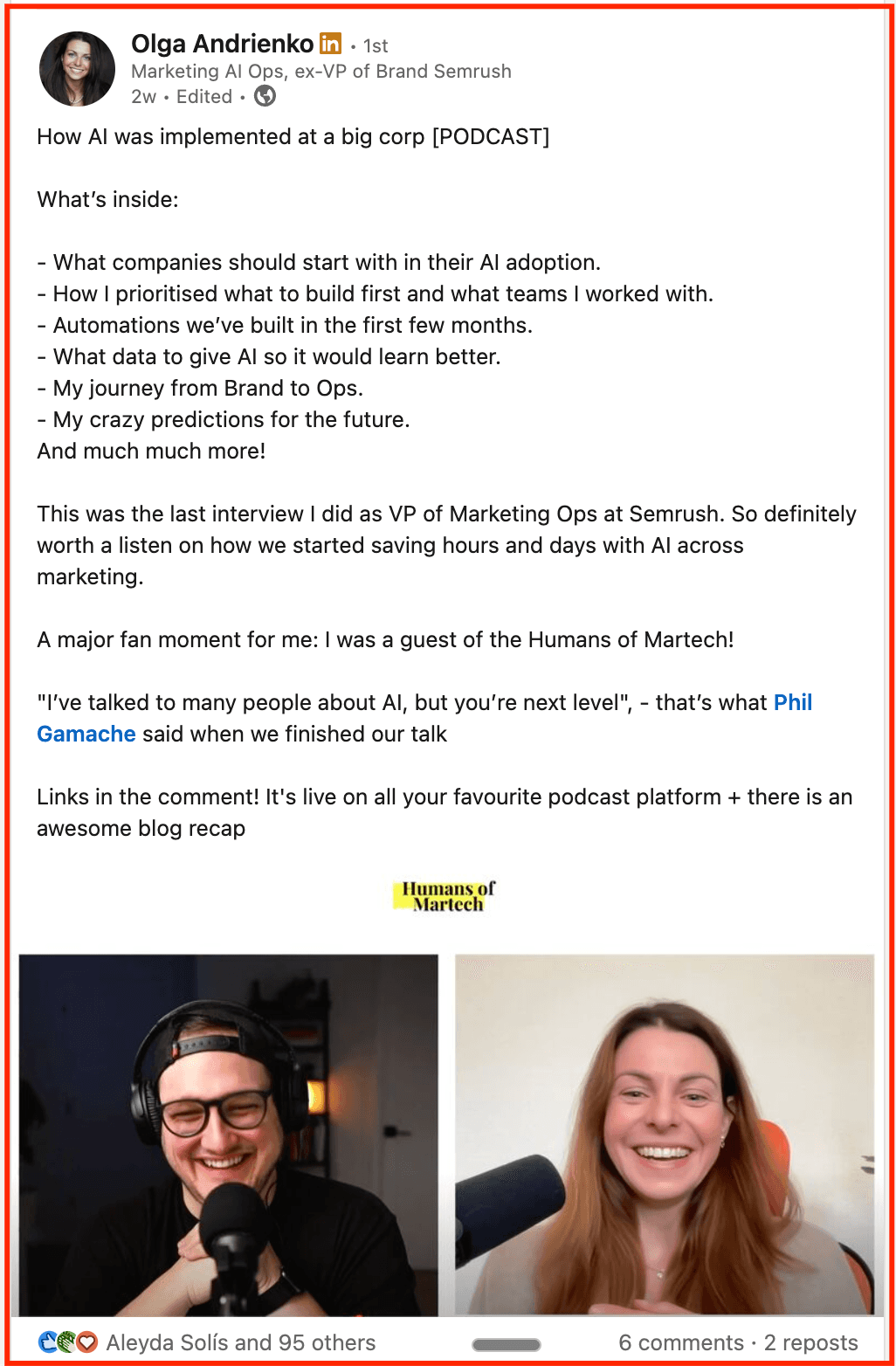
Formatting right can feel tedious. Supergrow’s post generator can help.
It automatically turns drafts into LinkedIn-friendly layouts with short paragraphs and bullets, so your posts stay skimmable without extra effort.
Step 6 – Personalize With Stories & Vulnerability
When writing a post on LinkedIn, numbers and tactics grab attention, but stories create a connection.
To be approachable or relatable-
Share a personal challenge
A BTS moment
Your failures
These stories work because they show the person behind the role while still tying back to a professional lesson. The key is balance. Vulnerability without a takeaway feels out of place, while vulnerability paired with insight feels valuable.
Try this structure:
Set up your context → Share a personal moment → Tie it to a lesson your audience can use |
Take this post from Nikos, an Investor and Managing Partner at IA Global Ventures, who wrote about how being an immigrant entrepreneur isn’t a disadvantage.
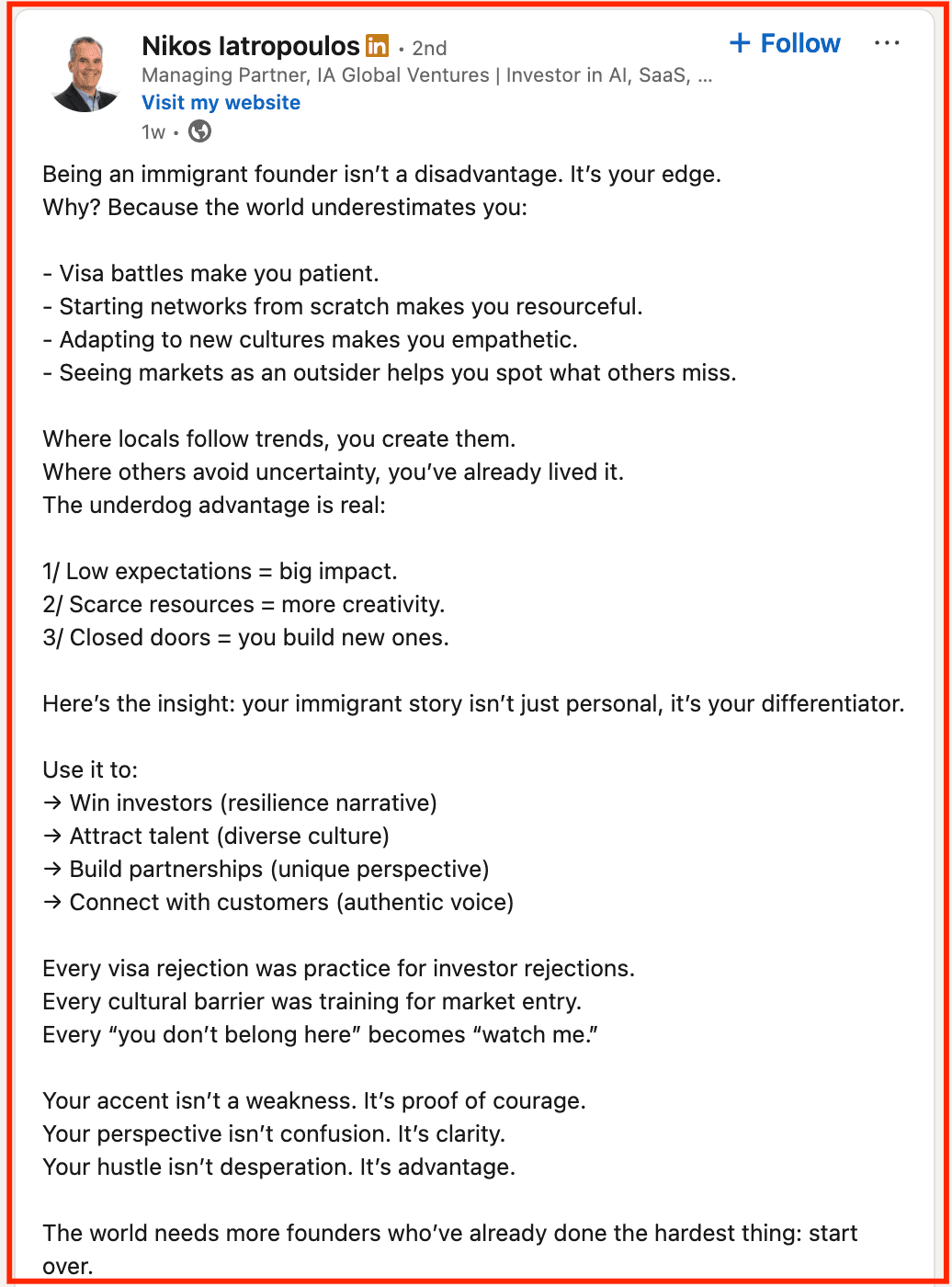
He shared his journey candidly, focusing on resilience and perspective. The result wasn’t just likes. It also sparked empathetic and insightful comments from people who resonated with his experience. That’s because he also tied the outcome to the business world.
Vulnerability like this doesn’t weaken authority; it strengthens it by showing the human side of leadership.
But if you struggle to capture your own tone, Supergrow can be trained on your past posts to generate content that mirrors your authentic voice so every story is distinctly yours.
Step 7 – Close With an Engagement Trigger
The end of your post is just as important as the beginning.
A strong close doesn’t just summarize a thought; it signals to readers that their input matters. This is crucial because comments are your key to LinkedIn growth.
More responses = more visibility.
Choosing the right engagement trigger depends on the job your post is doing.
If your goal is to spark debate, end with a direct question that invites opinions.
If you want relatability, prompt readers to share their own experiences.
If your post aims to drive action, close with a clear ask.
These small choices can make readers into participants and better the conversation quality and reach.
Writer Tim Denning often uses this style. In the post below, he shared how his daughter views his job. Then closed with a question.
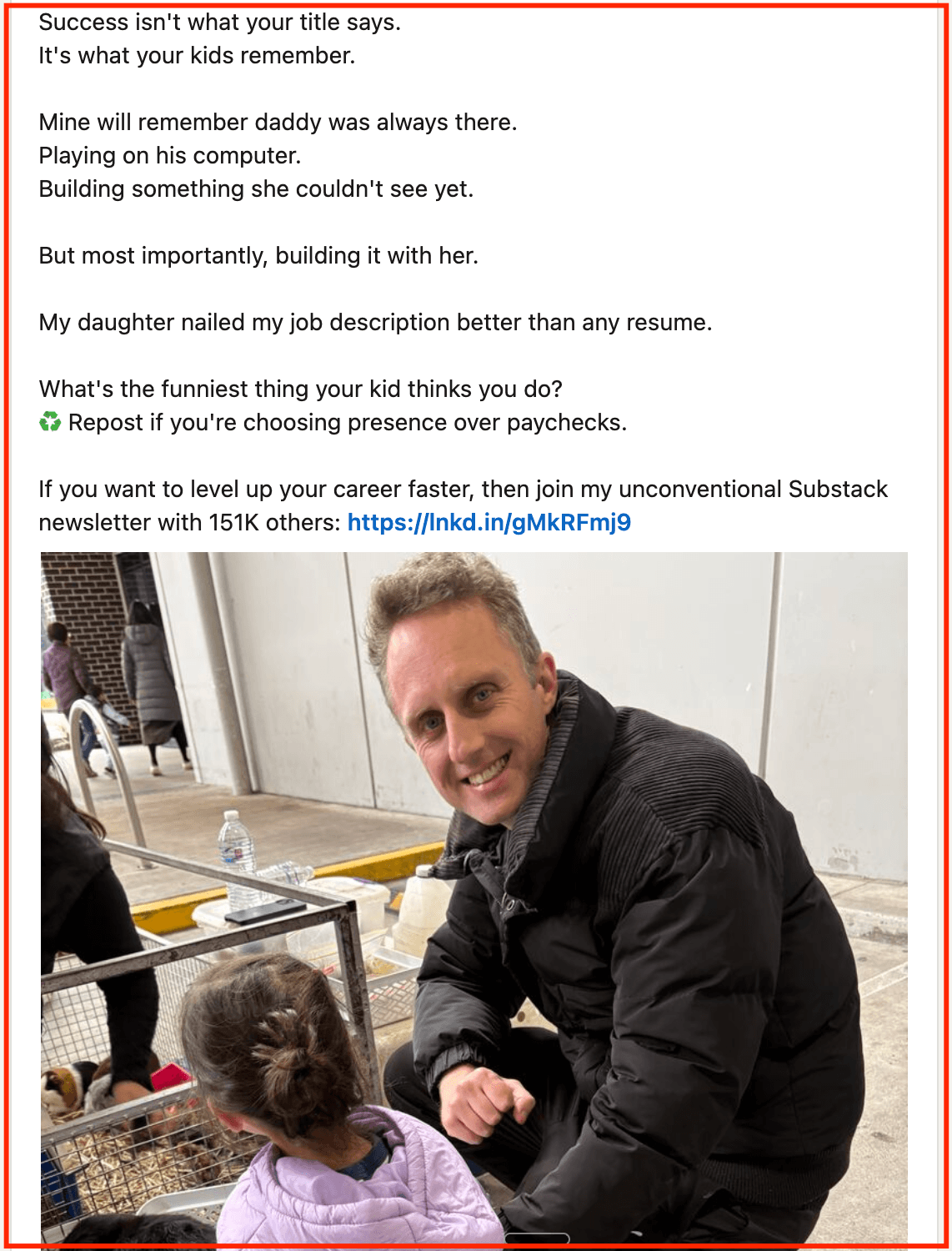
The comments section exploded with heartwarming comments that significantly boosted reach. So, if you want comments, ask for them. End with a question to turn a monologue into a dialogue.
Step 8 – Layer on Content Formats That Extend Reach
Text-only posts aren’t enough. LinkedIn prioritizes diverse formats that increase dwell time and interaction.
Carousels often outperform plain text because they encourage swiping, which boosts dwell time and leads to higher saves. For example, the post below-
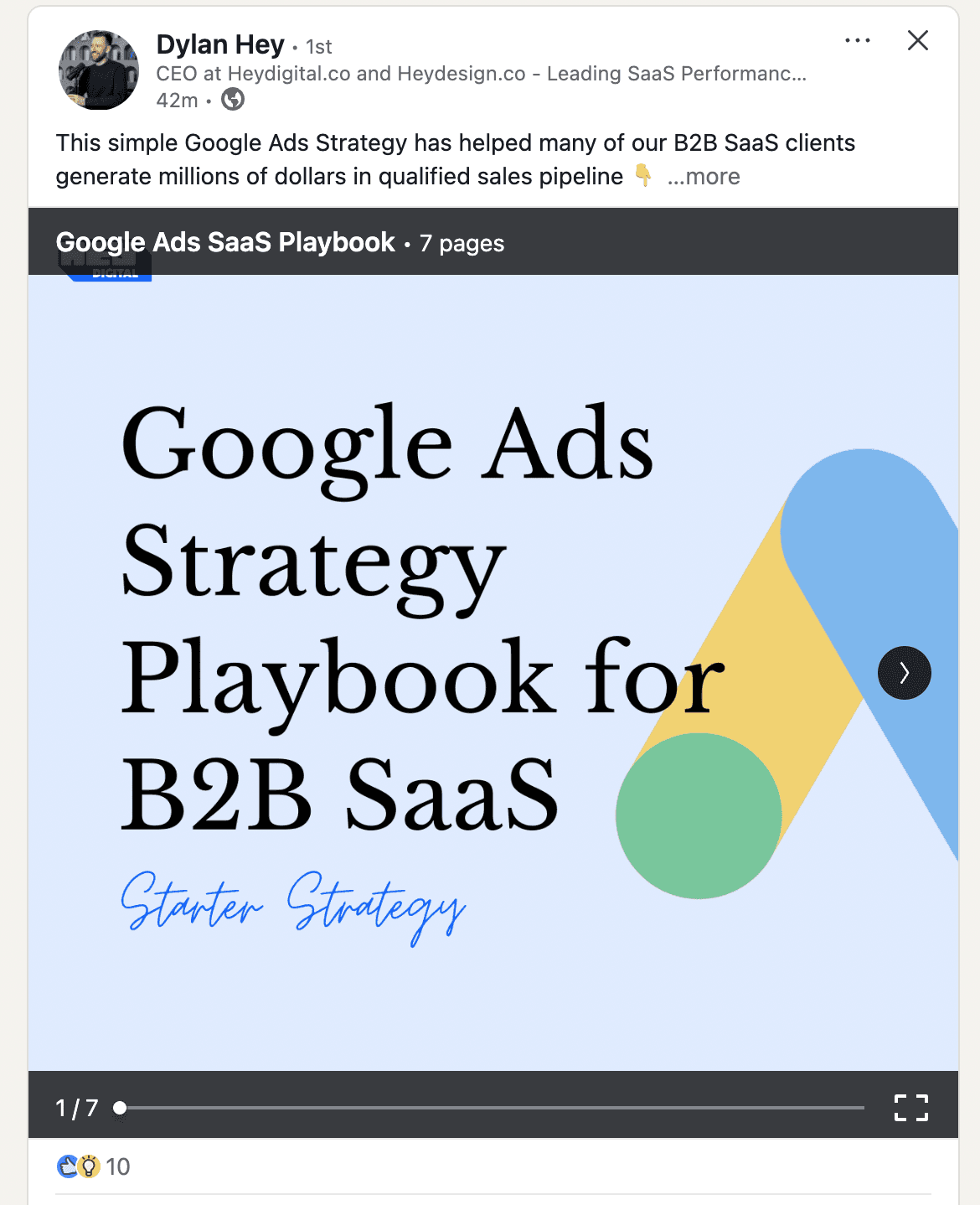
Short video clips under 90 seconds feel authentic because viewers hear your voice or see your face, which builds trust quickly.
Visuals like charts or infographics make data digestible and highly shareable, and can reach new audiences. For example, this post, “I started writing on LinkedIn 14 months ago.”
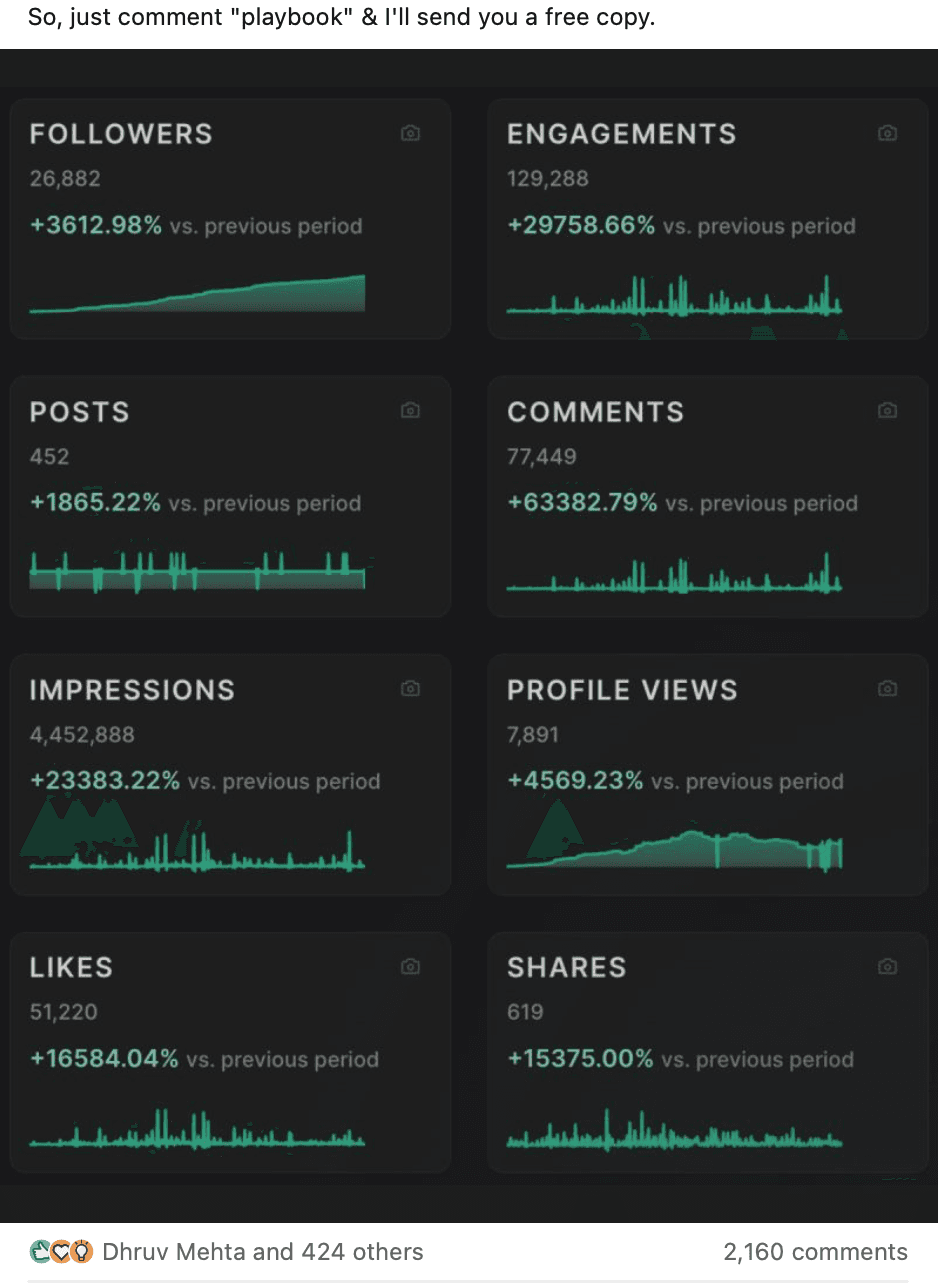
You could A/B test different formats with similar content to see what works for you.
Designing your posts is an added pain. You need to reformat the text, create visuals in Canva or another tool, and ensure that everything aligns with your brand. And not everyone has the skills for it.
Supergrow makes it simple to repurpose any draft into polished carousel posts aligned with your brand kit, so you get fast, branded, and consistent visuals without extra design work.
Step 9 – Optimize Timing, Consistency, and Early Signals
Posts that gain traction in the first hour get a huge lift. The algorithm watches for quick likes, comments, and dwell time before deciding whether to amplify your content. That’s why timing and consistency are as important as the writing itself.
According to Buffer’s analysis of over 1 million LinkedIn posts, the highest engagement windows are between 7 a.m. and 4 p.m. on weekdays, with Tuesday and Thursday mid-morning posts often outperforming others.
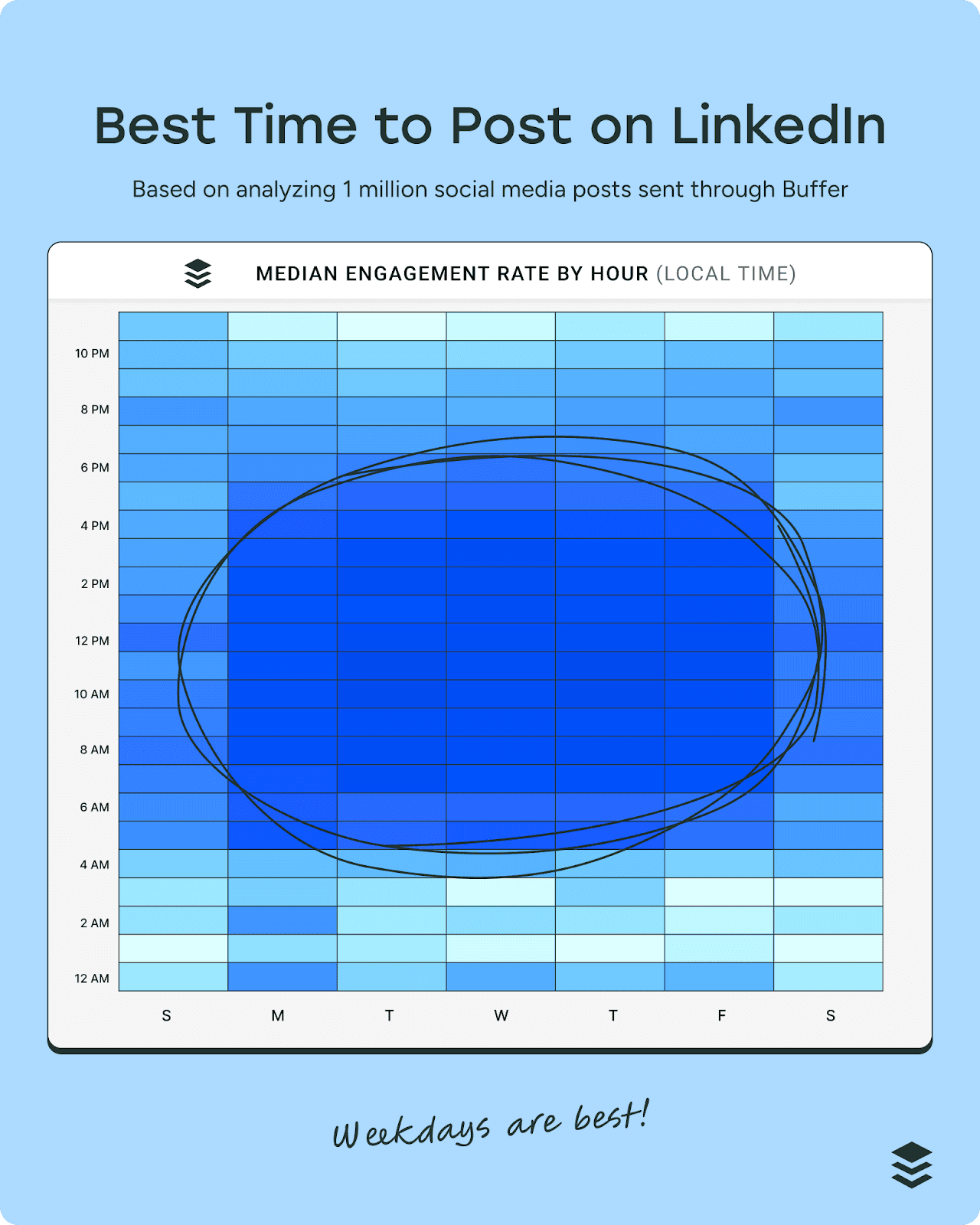
But don’t take these numbers at face value. Play around with days and timings, and check your analytics using LinkedIn’s “view analytics” feature under each post to find the right fit for you.
Manually keeping up with timing and engagement can feel like a full-time job. You need to remember to post during peak hours, add your first comment right after publishing, nudge colleagues to engage, and more. Miss one step, and the momentum is gone.
Supergrow’s scheduling feature takes that pressure off. You can plan posts, auto-schedule first comments with links or bonus insights, and keep your calendar consistent without chasing reminders.
How Supergrow Helps You Write Better LinkedIn Posts
Even with a clear framework, you may struggle to implement it effectively. Blank page anxiety, inconsistent posting, clunky scheduling, and not knowing what actually works are the biggest roadblocks to success.
Supergrow is designed to eliminate each of these pain points, allowing you to focus on writing posts that spark engagement.
Beat the Blank Page With AI That Knows Your Voice
The hardest part is often starting. You know you have to post, but the newer ideas don’t match the pace you need.
Instead of staring at a blank screen, you can feed Supergrow a blog, podcast, PDF, or even a video and instantly generate multiple LinkedIn-ready posts. You can use the variations it generates to post across longer spans, so you get more mileage from the single content piece.
You can train your personal AI on past posts so the posts sound authentic and you, not generic.

It means you never face the dreaded “what do I post today?” again.
Turn One Idea Into Multiple Engaging Formats
Carousels, videos, and visuals > text.
They drive higher reach because they keep readers engaged for longer.
Supergrow repurposes a single idea into carousels, text posts, and short snippets, so you don’t have to rebuild content from scratch.
These are styled with your brand kit for a professional look, and can help you reach your audience via formats they enjoy, so it increases saves and dwell time. This way, you maximize reach across LinkedIn with far less effort.

Schedule Smarter, Engage Faster
Native LinkedIn scheduling is rigid. You can’t easily edit, reschedule, or add engagement boosters.
The result? Stressful last-minute fixes, missed opportunities, and lower visibility because those critical first 60 minutes go underutilized.
Supergrow’s fixes this. The calendar view allows you to draft posts ahead of time, edit them as needed, and automatically queue first comments. But more importantly, this flexibility reduces the stress of being “always on,” saves hours of manual work, and ensures every post gets the early engagement signals LinkedIn rewards.
Instead of worrying about logistics, you focus on strategy, knowing your content is consistent, optimized, and ready to perform.

Learn What Works, Then Double Down
Instead of guessing, you can see exactly what resonates.
Supergrow’s analytics track follower growth, engagement velocity, and even your most active supporters, so you know which content to repeat. Leaning into proven formats to build momentum and compound results gradually.

Beyond that, you also get insights into profile and connection trends, and which post types drive the most reactions, comments, and saves. This makes it easier to spot patterns and understand not just what performed well, but why.

Applying these learnings can add to steady growth. If a particular hook style sparks more replies, you use it again. If carousels consistently earn higher saves, you reserve them for evergreen ideas.
Start Writing LinkedIn Posts That Truly Engage
Writing LinkedIn posts that perform isn’t about chasing luck or going viral overnight. You must show up consistently and lean on tools that make the process easier.
Most people struggle because they either don’t know what works or can’t sustain momentum long enough for the algorithm to reward them. With this guide, you have a repeatable process to create posts that can-
Gain attention
Start conversations
Open doors to new opportunities.
If you’re ready to stop guessing and start posting with confidence, give Supergrow a try. Turn every idea into a LinkedIn post that not only gets engagement —but drives real results for your brand.








